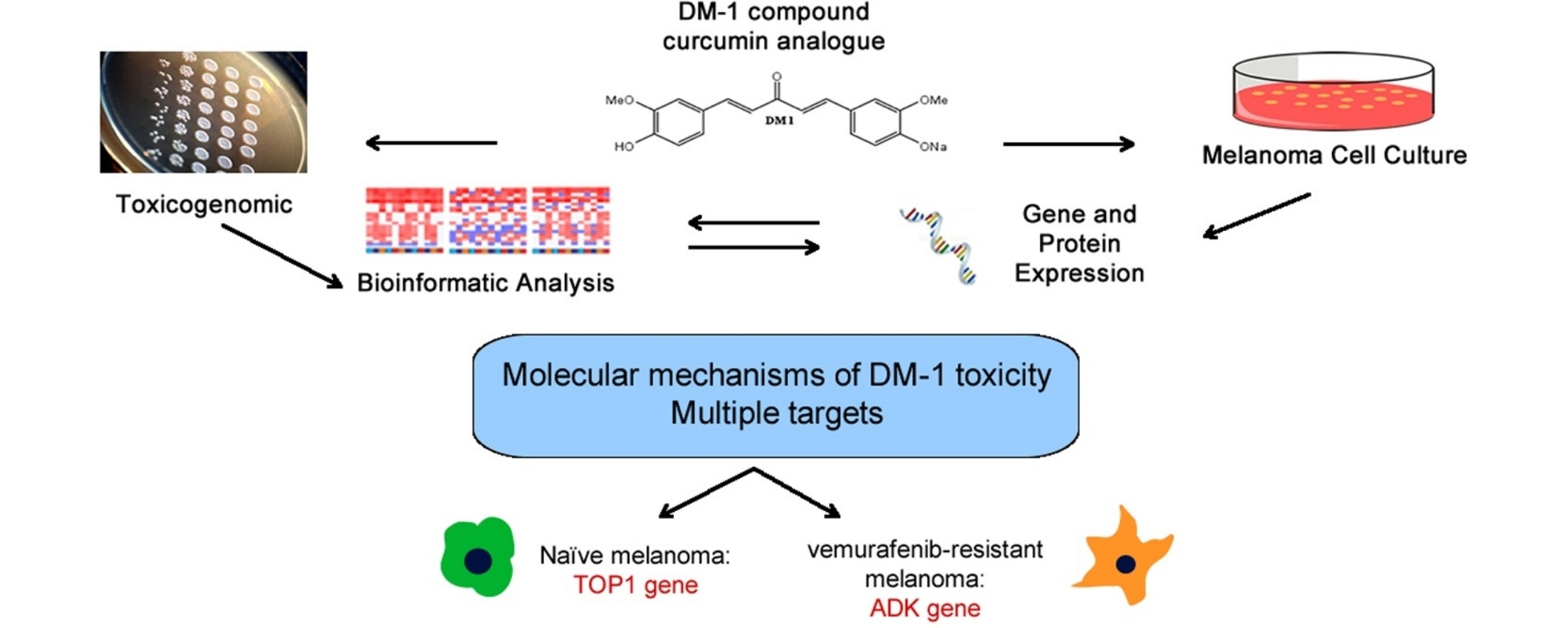Toxicogenomic and bioinformatics platforms to identify key molecular mechanisms of a curcumin-analogue DM-1 toxicity in melanoma cells.
Melanoma is a highly invasive and metastatic cancer with high mortality rates and chemoresistance. Around 50% of melanomas are driven by activating mutations in BRAF that has led to the development of potent anti-BRAF inhibitors. However resistance to anti-BRAF therapy usually develops within a few months and consequently there is a need to identify alternative therapies that will bypass BRAF inhibitor resistance. The curcumin analogue DM-1 (sodium 4-[5-(4-hydroxy-3-methoxy-phenyl)-3-oxo-penta-1,4-dienyl]-2-methoxy-phenolate) has substantial anti-tumor activity in melanoma, but its mechanism of action remains unclear. Here we use a synthetic lethal genetic screen in Saccharomyces cerevisiae to identify 211 genes implicated in sensitivity to DM-1 toxicity. From these 211 genes, 74 had close human orthologues implicated in oxidative phosphorylation, insulin signaling and iron and RNA metabolism. Further analysis identified 7 target genes (ADK, ATP6V0B, PEMT, TOP1, ZFP36, ZFP36L1, ZFP36L2) with differential expression during melanoma progression implicated in regulation of tumor progression, cell differentiation, and epithelial-mesenchymal transition. Of these TOP1 and ADK were regulated by DM-1 in treatment-naïve and vemurafenib-resistant melanoma cells respectively. These data reveal that the anticancer effect of curcumin analogues is likely to be mediated via multiple targets and identify several genes that represent candidates for combinatorial targeting in melanoma.
Authors
Érica Aparecida de Oliveira; Diogenes Saulo de Lima; Lucas Esteves Cardozo; Garcia Ferreira de Souza; Nayane de Souza; Debora Kristina Alves-Fernandes; Fernanda Faião-Flores; José Agustín Pablo Quincoces; Silvia Berlanga de Moraes Barros; Helder I Nakaya; Gisele Monteiro; Silvya Stuchi Maria-Engler
External link
Publication Year
Publication Journal
Associeted Project
Drug repositioning
Lista de serviços
-
Gene regulatory and signaling networks exhibit distinct topological distributions of motifs.Gene regulatory and signaling networks exhibit distinct topological distributions of motifs.
-
Gene signatures of autopsy lungs from obese patients with COVID-19.Gene signatures of autopsy lungs from obese patients with COVID-19.
-
Network Medicine: Methods and ApplicationsNetwork Medicine: Methods and Applications
-
ACE2 Expression Is Increased in the Lungs of Patients With Comorbidities Associated With Severe COVID-19.ACE2 Expression Is Increased in the Lungs of Patients With Comorbidities Associated With Severe COVID-19.
-
Drug repositioning for psychiatric and neurological disorders through a network medicine approach.Drug repositioning for psychiatric and neurological disorders through a network medicine approach.
-
Linking proteomic alterations in schizophrenia hippocampus to NMDAr hypofunction in human neurons and oligodendrocytes.Linking proteomic alterations in schizophrenia hippocampus to NMDAr hypofunction in human neurons and oligodendrocytes.
-
In-depth analysis of laboratory parameters reveals the interplay between sex, age, and systemic inflammation in individuals with COVID-19.In-depth analysis of laboratory parameters reveals the interplay between sex, age, and systemic inflammation in individuals with COVID-19.
-
The evolution of knowledge on genes associated with human diseasesThe evolution of knowledge on genes associated with human diseases
-
Network vaccinology.Network vaccinology.
-
Pyruvate kinase M2 mediates IL-17 signaling in keratinocytes driving psoriatic skin inflammationPyruvate kinase M2 mediates IL-17 signaling in keratinocytes driving psoriatic skin inflammation
-
Transcriptome analysis of six tissues obtained post-mortem from sepsis patientsTranscriptome analysis of six tissues obtained post-mortem from sepsis patients
-
Gene Signatures of Symptomatic and Asymptomatic Clinical-Immunological Profiles of Human Infection by Leishmania (L.) chagasi in Amazonian BrazilGene Signatures of Symptomatic and Asymptomatic Clinical-Immunological Profiles of Human Infection by Leishmania (L.) chagasi in Amazonian Brazil
-
In vitro morphological profiling of T cells predicts clinical response to natalizumab therapy in patients with multiple sclerosis.In vitro morphological profiling of T cells predicts clinical response to natalizumab therapy in patients with multiple sclerosis.
-
Integrative immunology identified interferome signatures in uveitis and systemic disease-associated uveitis.Integrative immunology identified interferome signatures in uveitis and systemic disease-associated uveitis.
-
Gene regulatory networks analysis for the discovery of prognostic genes in gliomas.Gene regulatory networks analysis for the discovery of prognostic genes in gliomas.
-
Revealing shared molecular drivers of brain metastases from distinct primary tumors.Revealing shared molecular drivers of brain metastases from distinct primary tumors.

